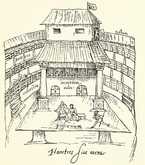Important events
(detail)1615 | closure
After 1615 the Swan was deserted for five years, but used again in 1621 by some actors who are unknown. They did not stay for long. In Nicholas Goodman's 1632 pamphlet Holland's Leaguer, the theatre is described as "now fallen into decay, and, like a dying swan, hangs her head and sings her own dirge."Historical sources do not mention the Swan after that date.
History
Additional information
No information has yet been entered
Add information








